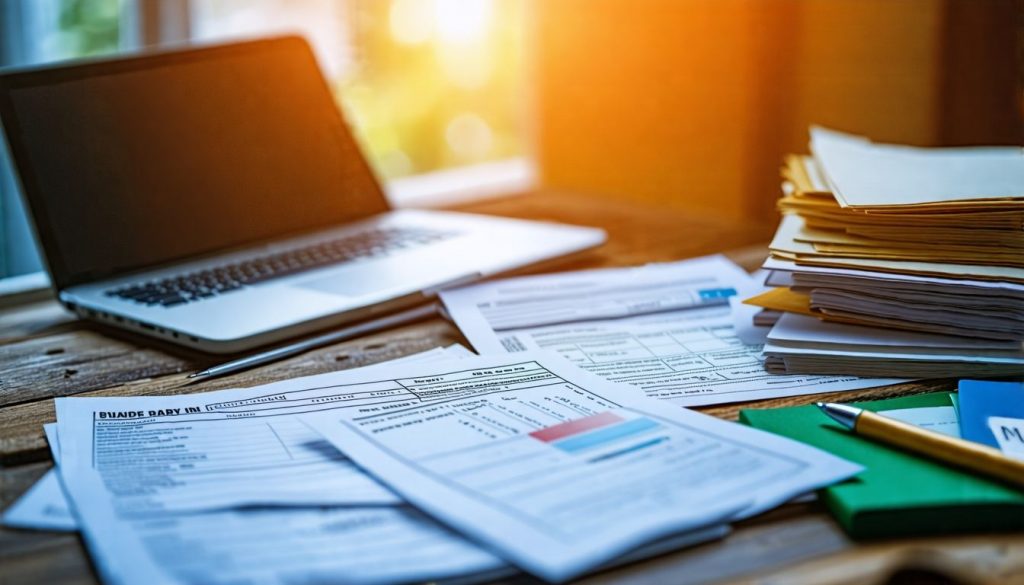Struggling with bankruptcy student loans can feel overwhelming. One key fact to know is that laws around debt discharge provide paths for relief. This article will explore options for managing or even discharging your student loan debt through bankruptcy and other means.
Keep reading to find hope.
Key Takeaways
- Bankruptcy can offer relief from overwhelming debt, but not all student loans are easily discharged this way. You must meet specific conditions, like the seven-year rule in Canada, to qualify for student loan discharge through bankruptcy.
- Exploring hardship provisions is essential if you’re struggling with student loan repayment. Programs like income-driven repayment plans and loan rehabilitation might help manage your debt more effectively.
- After declaring bankruptcy, negotiating with lenders and seeking financial hardship assistance are crucial steps towards finding better repayment terms or temporary relief from student loans.
- Consulting a specialist can provide valuable insights into managing your student loan debt after bankruptcy. They can guide you through options available based on Canadian regulations and help plan a strategy tailored to your situation.
- Being proactive about exploring alternative solutions post-bankruptcy helps regain financial stability. This includes understanding your rights within the bankruptcy court system and working towards effective repayment strategies for your educational loans.
What is Bankruptcy and How Does it Affect Student Loans?
Bankruptcy is a legal process that helps people unable to pay their debts. It can significantly affect student loans, as not all educational debt qualifies for discharge in bankruptcy.
Definition of bankruptcy
Bankruptcy is a legal process that provides individuals with relief from overwhelming debt. It allows people to either eliminate or restructure their financial obligations through the court system.
In Canada, bankruptcy can help those struggling with various types of debts, including student loans, but not all student loan debt qualifies for discharge. Specific rules apply under Canadian bankruptcy laws regarding how long one has had the loans and whether they have faced undue hardship.
The impact of bankruptcy on your financial situation can be significant. It affects credit ratings and may influence future eligibility for government student aid programs. Understanding these aspects is crucial for anyone considering this option as a way to manage their debt issues effectively.
Impact on student loan repayment
Bankruptcy can significantly impact student loan repayment in Canada. While federal and provincial government student loans are generally not dischargeable through bankruptcy, this does not eliminate the financial burden of these loans.
Borrowers may find themselves in long-term ineligibility for any new government student aid programs after declaring bankruptcy. This situation creates challenges as individuals attempt to navigate their financial obligations while managing ongoing repayment of both secured and unsecured debt.
Seeking relief options becomes crucial during this time. Negotiating with lenders or exploring alternative payment plans can alleviate some pressure. Consulting with an insolvency trustee offers guidance tailored to individual circumstances, allowing borrowers to understand their rights and potential solutions available post-bankruptcy.
Understanding these aspects sets the stage for discharging student loan debt effectively within the wider context of bankruptcy proceedings.
Eligibility for government student aid
Eligibility for government student aid can be affected by bankruptcy filings. In Canada, individuals who declare bankruptcy may face limitations in accessing financial aid programs for education.
If you have declared bankruptcy, your eligibility for federal and provincial government student loans might change, especially if the discharge affects your credit rating or financial standing.
While the seven-year rule applies, many Canadians still need to understand that they could experience long-term ineligibility following a bankruptcy. This means that discharging student loan debt through bankruptcy may lead to difficulties in securing new funding or assistance related to their educational pursuits.
Discharging Student Loan Debt in Bankruptcy
Discharging student loan debt in bankruptcy can be challenging. Certain conditions must be met to qualify for this option, especially when proving undue hardship.
The seven-year rule
The seven-year rule is a significant factor for Canadians considering bankruptcy and its impact on student loans. Under this rule, if you file for bankruptcy, any outstanding student loan debt may be discharged after seven years provided certain conditions are met.
Specifically, this applies to borrowers who have been out of school for at least five years before filing for bankruptcy. If these criteria are satisfied, individuals can potentially receive financial relief from their student loans.
While the seven-year timeline offers hope for relief in some cases, not all student loans qualify for discharge through bankruptcy. Government-funded student loans often have more stringent regulations and may remain eligible only under specific hardship provisions.
Understanding these nuances is crucial before pursuing any action as it influences overall eligibility for future government aid and impacts long-term financial planning regarding student debt repayment options.
Long-term ineligibility
Long-term ineligibility arises when a borrower faces challenges discharging student loans through bankruptcy. In Canada, if you do not meet specific criteria, such as the seven-year waiting period since your first loan repayment came due, you may find yourself unable to release these debts.
This situation often leaves individuals with ongoing financial hardships and limited options for student loan forgiveness or relief.
Facing this reality can stifle opportunities for obtaining government student aid. For many borrowers, it complicates their ability to rebuild credit and achieve financial stability after bankruptcy.
Understanding these restrictions is crucial as one considers alternative paths available in managing their education-related debt. Transitioning towards potential solutions requires exploring the next steps regarding alternatives after bankruptcy: seeking other avenues for assistance with student loans.
Hardship provisions
The hardship provisions offer specific relief options for Canadians facing difficulties with student loan repayment. They provide a pathway to manage debt effectively during challenging times.
- Eligibility Criteria
To qualify for hardship provisions, borrowers must demonstrate that they are experiencing significant financial distress. This may include reduced income, unexpected medical expenses, or loss of employment. Each lender may have different requirements for verifying financial hardship.
- Temporary Payment Relief
Many lenders allow borrowers to temporarily postpone payments through deferral or forbearance programs. During this time, interest may continue to accrue on the loan, increasing the total debt after the period ends. Understanding these conditions is crucial before opting for such relief.
- Loan Rehabilitation Programs
Students can often rehabilitate their loans as part of their recovery plan. Successfully completing a rehabilitation program can help restore good standing and eligibility for future federal student aid. This process usually requires consistent monthly payments over a specific duration.
- Income-Based Repayment Plans
Income-driven repayment plans adjust monthly payments according to the borrower’s income level and family size. These plans aim to make repayments manageable while providing a clear path towards loan forgiveness after 20-25 years of consistent payments.
- Accessing Financial Assistance Programs
Various programs exist specifically designed to help students in financial trouble manage their debts better. Local charities, government agencies, and nonprofit organizations often provide grants or loans aimed at reducing overall student loan burden.
- Seeking Guidance from Specialists
Consulting with student loan specialists can provide valuable insight into available options and strategies for managing debt effectively. These experts can help navigate Canada’s student loan regulations and recommend suitable solutions tailored to individual circumstances.
- Long-Term Consequences of Not Addressing Hardship
Failing to address financial hardship can lead to severe consequences like defaulting on loans or damaging credit scores significantly. Staying proactive about managing student loans enhances opportunities for future education financing and improves overall financial health.
Understanding these hardship provisions is essential for Canadians struggling with student loans in times of crisis, paving the way toward potential recovery without overwhelming stress.
Bankruptcy vs. Consumer Proposal for Student Loans
Bankruptcy and consumer proposals offer different paths for managing student loan debt. Each option impacts your credit and repayment strategy. Understanding these differences can help you make informed decisions about your financial future.
Explore further to find the best solution for your situation.
Difference in debt relief options
Understanding the difference in debt relief options, particularly between bankruptcy and consumer proposals, is crucial for Canadians struggling with student loan debt. Each option provides a different approach to managing and potentially eliminating debt. Below, we delve into the specifics of how these options impact student loan debt.
| Bankruptcy | Consumer Proposal | |
|---|---|---|
| Definition | A legal process where a debtor who cannot repay their debts is relieved of the debt obligations by the court. | A legally binding agreement facilitated by a Licensed Insolvency Trustee (LIT), where the debtor agrees to pay a portion of their debts over a period of time. |
| Impact on Student Loans | Student loans can be discharged if the bankruptcy is filed seven years after the student has ceased to be a part or full-time student. | Student loans can be included in a consumer proposal, potentially reducing the amount owed, if it’s been seven years since the debtor ceased to be a student. |
| Eligibility for Future Loans | Bankruptcy can make obtaining new loans difficult due to its impact on credit scores. | While a consumer proposal also affects credit, it may be viewed more favorably than bankruptcy by lenders. |
| Repayment Period | Not applicable as debts are discharged. | Debtor agrees to a repayment schedule, often up to a maximum of five years. |
| Benefits | Provides a fresh start by discharging eligible debts. | Allows for debt reduction while keeping assets and avoiding bankruptcy. |
| Considerations | Severe impact on credit score and public record of bankruptcy. | Requires regular payments; failure to comply can result in cancellation of the proposal. |
These debt relief options each offer pathways for Canadians with student loan debt to find relief under challenging financial circumstances. Choosing the right option depends on individual financial situations, goals, and the specifics of their debt.
How they affect student loan debt
Bankruptcy directly impacts student loan debt in significant ways. While discharging other types of unsecured debts is possible, student loans typically remain non-dischargeable unless specific conditions are met.
In Canada, the bankruptcy process does not automatically eliminate student loan repayment obligations after discharge if it has been less than seven years since studies were completed.
This long-term ineligibility complicates financial situations for many borrowers.
Borrowers may still explore hardship provisions to discharge their loans through a court application under the “undue hardship” criteria. Proving undue hardship often requires demonstrating inability to maintain a minimal standard of living while repaying debts and showing that the situation is likely to persist for a substantial portion of the repayment period.
Understanding how these elements play into bankruptcy will help individuals navigate their options effectively and make informed choices regarding student loan assistance after experiencing bankruptcy.
After Bankruptcy: Seeking Alternative Student Loan Solutions
After bankruptcy, borrowers can negotiate with lenders to find better repayment terms. They should explore different repayment options available for their situation. Financial hardship assistance programs can also provide valuable support.
Consulting a specialist may offer additional insights on managing student loan debt effectively. Discover more ways to tackle your student loans and regain financial stability.
Negotiating with lenders
Negotiating with lenders can be a strategic approach for Canadians dealing with student loan debt. Clear communication is essential when discussing repayment options or possible deferment.
Many lenders may offer flexible plans tailored to your financial situation, especially if you express genuine hardship. Being proactive in these discussions helps you explore alternatives like payment reductions or temporary pauses on payments.
Student loan rehabilitation programs are also worth considering during negotiations. These programs can help restore your eligibility for government student aid after experiencing financial difficulties.
Engaging directly with lenders about these programs often leads to better outcomes and prevents the negative consequences of defaulting on loans.
Exploring repayment options
Exploring repayment options is crucial for those facing difficulties with student loans after bankruptcy. Canadians can consider various plans, such as income-driven repayment programs, which adjust monthly payments based on income and family size.
These options can ease the burden of loan repayments and help borrowers avoid default.
Loan rehabilitation also provides a path to manage student debt. This process involves making a series of agreed-upon payments, allowing individuals to regain good standing with their lenders.
Seeking financial hardship assistance may further open doors to alternative solutions tailored to personal circumstances.
Seeking financial hardship assistance
Seeking financial hardship assistance offers a vital pathway for individuals struggling with student loan repayments. Various programs exist to alleviate the burden of student loans, especially after experiencing bankruptcy.
Many lenders have options that allow borrowers to negotiate more manageable repayment plans or defer payments based on their current income and expenses.
Canadians can also explore government-funded resources designed to support those in financial distress. These may include eligibility assessments for reduced payment amounts or temporary relief from loan obligations.
Utilizing such assistance can significantly ease the strain of student loan debt and help individuals regain stability post-bankruptcy while aiming for effective repayment solutions.
Seeking advice from a specialist
Consulting a specialist is essential for understanding the complexities of bankruptcy and student loans. Professionals in this field can provide expert guidance tailored to your situation.
They assist in identifying viable loan repayment options and strategies for financial hardship assistance. Their knowledge extends to Canada’s specific regulations regarding student loans, ensuring you receive accurate information.
An experienced advisor can help you navigate eligibility issues for government student aid after bankruptcy. They clarify potential consequences of not paying student loans and inform you about your rights within the bankruptcy court system.
This support is invaluable when considering options like student loan rehabilitation or exploring credit negotiation tactics after discharge.
Conclusion
Understanding the discharge of bankruptcy student loans is crucial for Canadians facing financial challenges. Bankruptcy does not automatically erase all student loan debt, but specific conditions may allow for some relief.
Exploring options such as negotiating with lenders or seeking financial hardship assistance can lead to viable solutions post-bankruptcy. Take proactive steps to regain control over your finances and understand your rights regarding educational loans.
FAQs
1. What does it mean to discharge bankruptcy student loans?
Discharging bankruptcy student loans means that the borrower is released from the obligation of repaying their student loans due to financial ineligibility.
2. How does bankruptcy impact my Canada student loan regulations?
Bankruptcy can have a significant effect on your Canada student loan regulations, potentially leading to loan discharge or changes in eligibility for future aid.
3. Can I get any form of aid after declaring bankruptcy over my defaulted student loan?
Yes, depending on individual circumstances and specific rules, you may regain eligibility for student aid after undergoing a process related to repayment of your bankrupted loans.
4. What are some options if I default on my Student Loan in Canada?
There are various options available including negotiating new terms with lenders or exploring the possibility of discharging the debt through bankruptcy.








